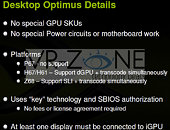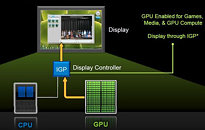Monday, April 25th 2011

NVIDIA to Launch Optimus-like Technology for Desktops at Computex 2011
While NVIDIA and AMD are just about done with their consumer GPU launches for the current generation, NVIDIA has something in store for Computex, 2011, one of the year's biggest technology tradeshows. The GPU giant will announce NVIDIA Optimus technology's desktop avatar, for now known as "Synergy". The technology allows on-the-fly switching between a computer's integrated graphics and discrete NVIDIA GeForce graphics processor, giving you access to the feature-set of both, and allowing a fair amount of power-saving in the process.
NVIDIA's new technology is designed specifically for Intel's Sandy Bridge desktop platform, particularly motherboards with Intel H61, H67, and Z68 chipsets (you can't access IGP with P6x). Unlike SLI, motherboard vendors needn't shell out a license fee or sign an agreement to implement the technology. A supportive motherboard will have authorization code implanted into SBIOS, much like SLI. In practice, the technology will allow users to switch to a GeForce GPU (or a pair of GPUs on Z68) when gaming or in 3D-heavy applications; while falling back to the power-efficient IGP or even making use of Intel's QuickSync technology, when not gaming.The display is connected to the IGP (motherboard), when the discrete GPUs are active, the IGP functionally turns into a display controller (like NVIO2) while the discrete GeForce GPUs render ultra-complex graphics and PhysX. When the discrete GPUs are inactive, the IGP is in-charge of all graphics rendering (including Windows Aero UI). The user can manually switch on-the-fly, or set up profiles to switch when a particular application/game is launched.
Source:
VR-Zone
NVIDIA's new technology is designed specifically for Intel's Sandy Bridge desktop platform, particularly motherboards with Intel H61, H67, and Z68 chipsets (you can't access IGP with P6x). Unlike SLI, motherboard vendors needn't shell out a license fee or sign an agreement to implement the technology. A supportive motherboard will have authorization code implanted into SBIOS, much like SLI. In practice, the technology will allow users to switch to a GeForce GPU (or a pair of GPUs on Z68) when gaming or in 3D-heavy applications; while falling back to the power-efficient IGP or even making use of Intel's QuickSync technology, when not gaming.The display is connected to the IGP (motherboard), when the discrete GPUs are active, the IGP functionally turns into a display controller (like NVIO2) while the discrete GeForce GPUs render ultra-complex graphics and PhysX. When the discrete GPUs are inactive, the IGP is in-charge of all graphics rendering (including Windows Aero UI). The user can manually switch on-the-fly, or set up profiles to switch when a particular application/game is launched.


15 Comments on NVIDIA to Launch Optimus-like Technology for Desktops at Computex 2011
AS in no power to it at all
I see its benefit in gaming laptop situations, but not sure its really needed on any desktops though.
I don't think AMD needs anything similar, their idle power consumption is pretty minimal as it is.